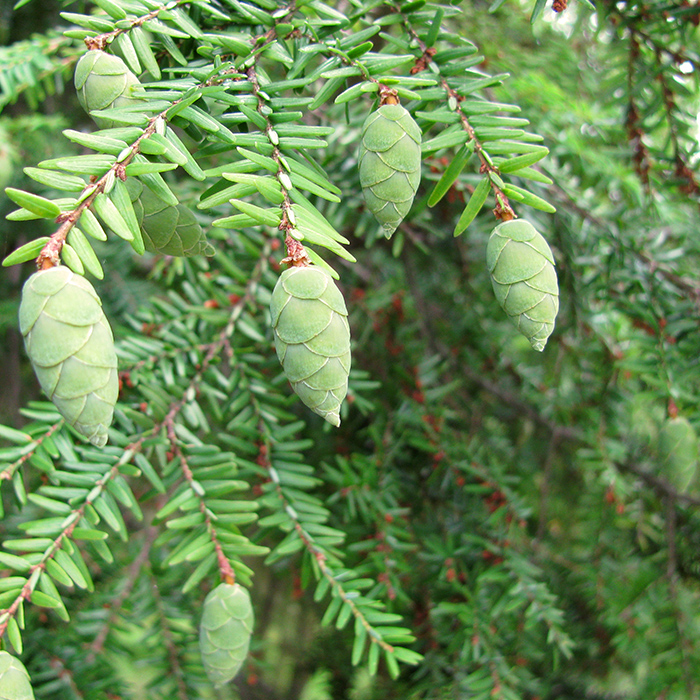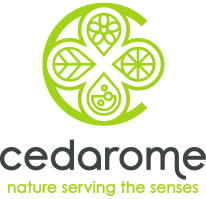Description
Eastern Hemlock essential oil is sourced from the Canadian Boreal forest. It is obtained from the needles and twigs of the Tsuga canadensis tree through steam distillation. It is a colorless to pale yellow liquid with a unique aroma.
Olfactive Profile
A very unique, rich and warm coniferous scent, with spicy and fruity facets.
Woody
Aromatic
Flavor Profile
Fresh and medicinal.
- Details
- Technical Sheet
- Downloads
- Sources
Details
Botany:
Tsuga canadensis, commonly known as Eastern Hemlock, is an evergreen tree native to the forests of northeastern North America, is a member of the Pinaceae family, and is botanically classified as a conifer.
Eastern Hemlock grows well in the shade, is moderately slow-growing and long-lived. The imposing tree generally reaches over 31 meters in height. In shape, the crown is conical.
Ethnobotany:
Tsuga canadensis has long been considered to be a powerful medicinal plant in Indigenous cultures, in which all parts of the tree were used for different purposes. Eastern Hemlock needles and twigs were used in infusions, decoctions and poultices to treat colds, coughs, rheumatisms and skin infections. Most notably, hot infusions containing Eastern Hemlock twigs were used as a steam treatment for muscle swelling and stiff joints.
Uses:
The essential oil obtained by steam distillation contains I-Bornyl acetate, which is one of the major components that gives the conifer its unique and powerful aroma.
In a circular economy approach, Cedarome uses the twigs and needles left behind as byproducts of the lumber industry as the primary source for the production of Eastern Hemlock essential oil. Applications include fine fragrance, cosmetics, flavour/food and aromatherapy.
Technical Sheet
Botanical name: Tsuga canadensis (L.) Carr.
Botanical family: Pinaceae
Accepted synonyms: Pinus canadensis
Common names: Canadian Hemlock, Eastern Hemlock, Eastern Hemlock-Spruce, Hemlock Spruce
Origin: North America
Source: Canada
Cultivation method: Wild harvested
Harvest period: April to November
Plant part used: Needles and twigs
Method of extraction: Steam distillation
Main components: I-Bornyl Acetate, α-Pinene, Camphene, Tricyclene, I-Limonene, β-Pinene
CAS: 8008-80-8 / 90045-63-9
INCI: Tsuga canadensis leaf oil
FEMA: 3034
EC: 289-926-6
Appearance: Colorless to pale yellow liquid with a characteristic odor
Certifications and Declarations:


- Certificate of Analysis
- Safety Data Sheet
- Food Grade Statement
- Natural Statement
- Origin Statement
- GMO Free
- Allergen
- No Animal Testing
- Prop 65
Downloads
Sources
BRIT – Native American Ethnobotany Database. (n.d.). Naeb.brit.org. http://naeb.brit.org
Integrated Taxonomic Information System. (2019). Itis.gov. http://www.itis.gov
Kricher, J. C., Morrison, G., National Audubon Society, National Wildlife Federation, & Tory, R. (1998). A
Field guide to Eastern forests : North America. Houghton Mifflin.
Marie-Victorin, Frère F.É.C, Luc Brouillet, Rouleau, E., Goulet, I., & Hay, S. (2002). Flore laurentienne. G.
Morin.
Moerman, D. E. (1998). Native American ethnobotany. Timber Press.
Petrides, G. A., Wehr, J., National Audubon Society, National Wildlife Federation, & Tory, R. (1998). A field
guide to eastern trees : eastern United States and Canada, including the Midwest. Houghton Mifflin.
Welcome to the PLANTS Database | USDA PLANTS. (2016). Usda.gov. http://plants.usda.gov






